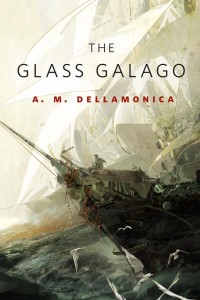On Wednesday in Saratoga Springs I got to see three variations of this spectacular cover for “The Glass Galago,” which is the third* of The Gales and which will be out in a couple months. Irene Gallo showed me this lush and beautiful Richard Anderson image, and I squealed like a little child newly in possession of all the ice cream.
*The first two Gales are Among the Silvering Herd and The Ugly Woman of Castello di Putti.
I am sitting in the hotel room in Saratoga Springs as I write this, checking my UCLA classrooms and talking with my students about what makes a person or non-human character monstrous. They’re asking: is the monstrous always just about making someone Other? Some might say any ordinary person with a defective moral compass–your classic heartless killer or other all-too-human predator– can be a monster. And in non-fiction, that scans for me. If a journalist wants to call Charles Manson a monster, I’m not going to quibble.
In fiction, my taste runs to the more than human monsters. I like for them to have a whiff of the transcendent. In the above series of stories, Gale Feliachild occasionally regards Captain Garland Parrish as monstrous, even though he’s not even remotely evil. He’s overly blessed by nature, you see: impossibly handsome, exceedingly graceful, and good at almost everything he turns his mind to. It’s just about too much. He’s good, but he can easily be jealousy-inducing. We all know people like this: coveting their good fortune makes us feel small, and it’s hard not to blame them.
The current TV version of Hannibal Lecter has an intense aestheticism and is so robustly athletic that he’s as hard to kill as The Terminator. Some of his qualities are appealing–his love is so pure!–and that makes his compulsion to kill and eat the rude all the more awful. And the fact that we can empathize with the idea of quelling the rude, neglectful and genuinely awful people we run across from time to time actually increases the effect… it invites us to consider whether we might not condone more than we should.





